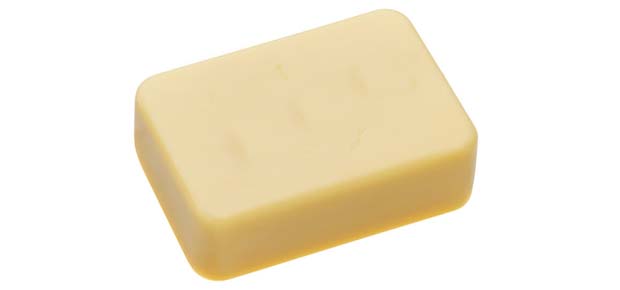The manufacturing of soaps consist of a comprehensive range of processing and packaging activities. The complexity the activities involved in soap manufacturing process may vary from small plants that employ a few people to those with many hundred workers. products may range from all purposes and uses to those that for used for a specific application or requirement.
The first step in the manufacturing of bar soaps is the selection of raw materials. Raw materials are selected on the basis of several factors, which may include human and environmental safety, cost, compatibility with other soap ingredients, and the appearance and performance characteristics of the final product. While the actual production process may vary from manufacturer to manufacturer and company to company, there are some steps that are common to all bar soaps.
The traditional bar soaps are made from oils, fats or their fatty acids that are reacted with inorganic water soluble bases. The prime sources of fats are beef and mutton tallow, while coconut, palm and palm kernel oils are the main oils that are used in soap manufacturing. The raw materials of a bar soap can be pretreated to remove impurities and to achieve the desired color, odor and performance characteristics desired in the finished bar.
Bar soap can be manufactured by either using batch or continuous process. Soap was manufactured by using batch kettle boiling method, until shortly after World War II, when continuous processes were developed. Now days, continuous process of soap making are preferred because of their speed,
flexibility and cost economy.
Both the batch as well as continuos soaps making processes produce the soap in liquid form (known as neat soap), and a valuable by-product, glycerin.
The glycerin is recovered from the soap mixture using the chemical treatment, which is followed by evaporation and refining. Refined glycerin is a valuable and expensive industrial material that is used in various products including cosmetics, foods, drugs, and many more.
The next steps after the saponification or neutralization process is drying. Vacuum spray drying is a technique, which is used to convert the neat soap into pellets of dry soap. The moisture content of the soap pellets may vary depending on the desired characteristics and properties of the soap bar.
In the final stage of processing, the dry soap pellets pass through a bar soap finishing line. The first unit in the line is a mixer (known as amalgamator), in which the soap pellets are blended together with colorants, fragrances, and many other ingredients as per the desired characteristics and properties in the final product. The mixture is then homogenized and refined using refining plodders and rolling mills to achieve thorough blending and a standard texture. In the end, the mixture is continuously extruded from the plodder, cut into bars of desired sizes and stamped into its final shape in a soap press.
Some of bar soaps available today are known as "combo bars" as they get their cleaning action from a combination of synthetic surfactants and soaps. Another bar soap bars, known as "syndet bars," feature surfactants as their prime cleansing ingredients. The processing technique for producing the synthetic base materials for these bars is very different from that, which is used in traditional soap making. However, with some minor modifications and adjustments, the finishing line equipment are same for both.
The industrial soap making involves four basis steps -
These different steps involve various processing steps and operations in their own. A brief description of these different steps is given below -
Saponification
The saponification process involves the mixing of tallow (animal fat) and
coconut oil with sodium hydroxide and the application of heat. The process
results in formation of soap, which is a salt of long chain carboxylic acid.
Glycerin Removal
Glycerin is more valuable than soap, and hence most of it is removed for
its uses in more expensive cosmetic products. Some of the glycerin is left
in the soap to make it soft and smooth. Soap is generally not very soluble
in salt water, while glycerin is, hence the salt is added to the wet soap
thereby causing it to separate out into glycerin and soap in salty water.
Soap Purification
In the soap purification stage, any remaining sodium hydroxide is
neutralized with a weak acid, like citric acid and two thirds of the
remaining water is removed to obtain pure soap.
Finishing
The final stage of industrial soap manufacturing process, finishing stage
involves mixing of additives, such as colors, preservatives, and perfume
into soap, which is then shaped into bars for sale.
Toilet soap generally has less water and more fatty material than laundry soap and because of this, the base soap intended for manufacturing toilet soap usually has extra fatty acids that are blended with preservatives before it is vacuum dried. These measures ensure that there is no unreacted caustic remains in the soap by the time it reaches the consumer, and also make the soap softer. Additives, such as perfume, dye and opacifier are then mixed to the dried soap and the mixture is milled to ensure even mixing. It is then plodded and extruded out as a continuous bar, which is cut into billets and stamped ready for packaging and sale.

If you have decided to make soap at home, you will need soap making supplies in the form of raw materials, soap making equipment & tools ...
Read More
Someone has rightly said that clothes are not just clothes. They form an integral part of a person's personality and tell a lot about their nature and...
Read MoreCleansing products play an important role in the daily lives of people.
Both soaps and detergents are cleansing products that we frequently use in our
Soap is designed as a product to be used once and then flushed down the drain...